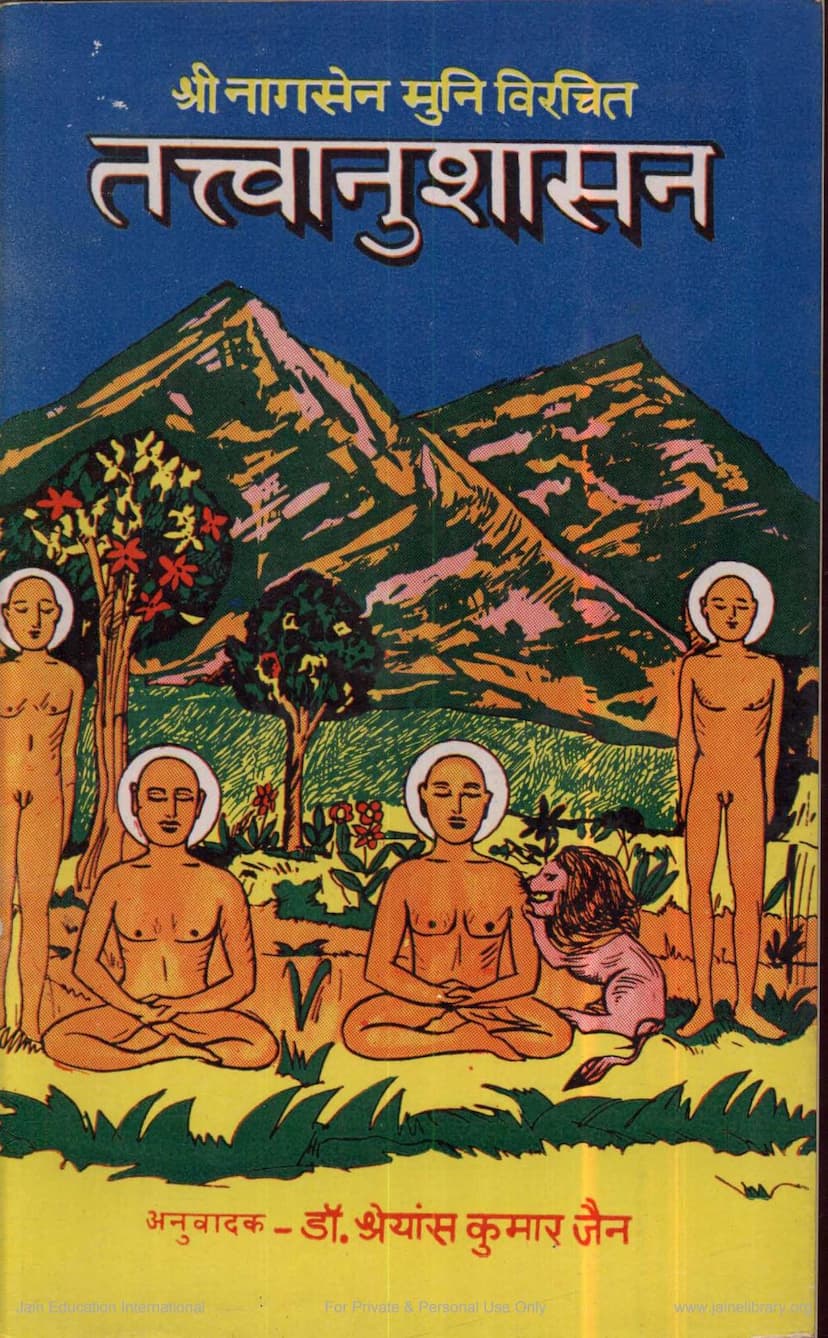Tattvanushasan
Added to library: September 2, 2025

Summary
This document is the Tattvanushasan (तत्त्वानुशासन), a Jain text authored by Muni Nagsen (श्री नागसेन मुनि) and edited by Bharat Sagar Maharaj (भरतसागरजी महाराज). Published by Bharat Varshiya Anekant Vidwat Parishad, it is presented as the 15th volume in a commemorative publication series for the Diamond Jubilee of Acharya Vimal Sagar Ji Maharaj.
The text is a comprehensive treatise on Jain philosophy and practice, with a particular focus on meditation (ध्यान) and the path to spiritual liberation (मोक्ष).
Here's a breakdown of the key themes and content based on the provided pages:
Core Philosophical Concepts:
- Tattvas (Principles): The book expounds on fundamental Jain principles, including the nature of the soul (जीव), non-soul (अजीव), soul's bondage (बन्ध), its causes (हेतु), liberation (मोक्ष), and the means to achieve it.
- Duality of Principles: It emphasizes the dual nature of principles as either "to be abandoned" (हेय) or "to be adopted" (उपादेय). Bandha (bondage) and its causes are considered हेय, while Moksha (liberation) and its causes are considered उपादेय.
- Karma: The text details the concept of karma, its bondage, and its role in the cycle of birth and death (संसार).
- The Path to Liberation (Moksha Marga): The core path to liberation is identified as the Ratnatraya (रत्नत्रय) – Right Faith (सम्यग्दर्शन), Right Knowledge (सम्यग्ज्ञान), and Right Conduct (सम्यक्चारित्र). These are presented as both the goal (साध्य) and the means (साधन) through the lens of Nischaya (ultimate truth) and Vyavahara (conventional truth)naya.
Emphasis on Meditation (Dhyana):
- Importance of Dhyana: A significant portion of the text is dedicated to the practice and importance of meditation as the primary means to attain Moksha. It argues that both Nischaya and Vyavahara paths to liberation are achieved through meditation.
- Types of Meditation: The text discusses various types of meditation, including:
- Artadhyana (आर्तध्यान) and Raudradhyana (रौद्रध्यान): Considered impure and to be avoided (दुःध्यान), as they lead to further bondage.
- Dharmadhyana (धर्म्यध्यान) and Shukladhyana (शुक्लध्यान): Considered pure and beneficial for liberation (सद्ध्यान), to be practiced by aspirants.
- Nishiddha (Prohibited) and Vidheya (Prescribed) Practices: It clarifies that in the current age (Pancham Kal), Shukladhyana is generally not considered attainable due to lack of the required spiritual potency (like Vajra Rishabha Narach Samhanana and extensive scriptural knowledge). Therefore, the focus shifts to the practice of Dharmadhyana, which is achievable even for those with less scriptural knowledge, provided they have a pure heart and consistent effort.
- Eight Limbs of Yoga (Ashtanga Yoga): The text reinterprets the eight limbs of yoga in a Jain context, focusing on the meditator (ध्याता), the object of meditation (ध्येय), the process of meditation (ध्यान), its fruit (फल), the subject of meditation (यस्य), the place (यत्र), the time (यदा), and the method (यथा).
- Methods and Objects of Meditation: It provides detailed descriptions of various meditation practices, including:
- Padashtha Dhyana (पदस्थ ध्यान): Meditation on letters, mantras (like Namokar Mantra), and specific sounds. It explains different methods of chanting and visualization related to the Pancha Parameṣṭhis (Arhat, Siddha, Acharya, Upadhyaya, Sadhu) and seed syllables.
- Pindastha Dhyana (पिण्डस्थ ध्यान): Visualization of the self and divine figures through various bodily postures and symbolic representations. This includes detailed descriptions of the five types of Pindastha Dhyana (Parthiva, Agneyi, Maruti, Varuni, Tattvatrayi).
- Dravya Dhyana (द्रव्य ध्यान): Meditation on the essential nature of soul (Jiva Dravya) as the most important object of meditation.
- Bhava Dhyana (भाव ध्यान): Meditation on the qualities and states of the soul, including contemplation of virtues and the path to liberation.
- Nij-Svarupa Dhyana (निज स्वरूप ध्यान): Meditation on the true, pure, and liberated nature of the soul, often described as the ultimate and most effective form of meditation.
Guidance for Sadhaks (Practitioners):
- Role of Gurus: The text stresses the importance of guidance from qualified gurus for the practice of meditation and adherence to Jain principles.
- Conquering the Mind: It emphasizes the critical role of controlling the mind (मन को जीतना) and senses (इन्द्रियों की विजय) through practices like contemplation of principles (Anupreksha), scriptural study (Swadhyaya), and detachment (Vairagya).
- Renunciation and Equanimity: The text promotes renunciation of worldly possessions and affections (परिग्रह त्याग), control of passions (कषाय निग्रह), and maintaining equanimity (समता) in all situations.
- Patience and Persistence: It encourages consistent practice and effort, even when facing challenges or perceived limitations in spiritual progress.
Context and Significance:
- Commemorative Publication: This edition is a significant publication celebrating the 75th birth anniversary of Acharya Vimal Sagar Ji Maharaj, highlighting the importance of Jain literature and scriptural propagation.
- Countering Misinterpretations: The introductory blessings and messages suggest a concern about contemporary misinterpretations of Jain doctrine, particularly the emphasis on "Nishchaya Naya" (ultimate truth) to the exclusion of "Vyavahara Naya" (conventional truth), and the need to preserve the authenticity of scriptural teachings.
In essence, Tattvanushasan serves as a profound guide for Jain ascetics and lay followers, outlining the philosophical underpinnings of the faith and providing practical instructions on how to cultivate spiritual progress and ultimately achieve liberation through the dedicated practice of meditation and virtuous conduct.